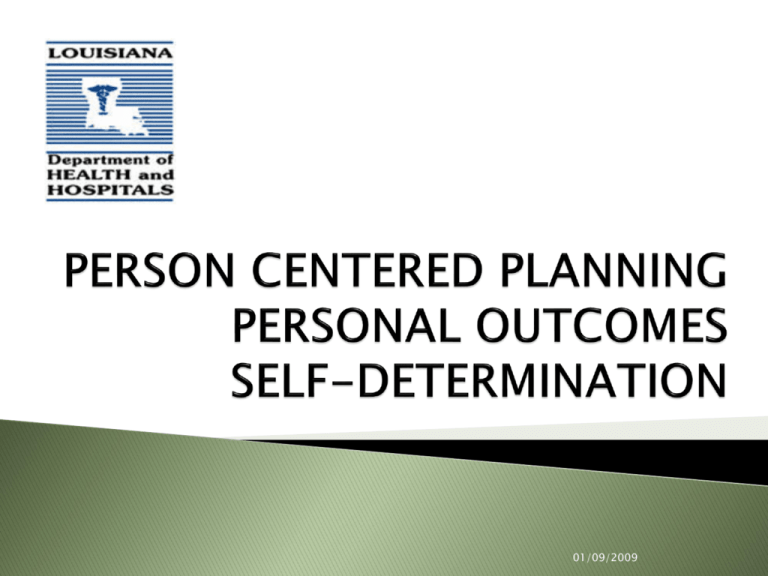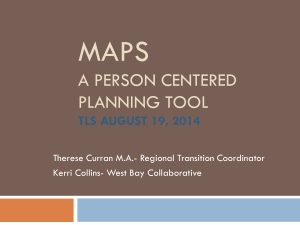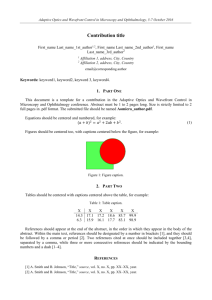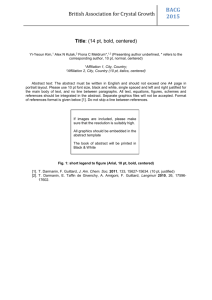person centered planning personal outcomes self
advertisement

01/09/2009 At the end of this session, the participants will be able to: ◦ Define Person Centered Planning, Personal Outcomes and Self-Determination ◦ Explain the difference between traditional planning and Person Centered Planning ◦ Explain the consumer’s choices when utilizing Personal Outcomes ◦ Explain the principles for using Personal Outcome Measures ◦ Explain the steps to using outcomes in planning 01/09/2009 ◦ ◦ ◦ ◦ ◦ ◦ Explain the qualities of good planning Define the consumer’s role in planning Describe the members of the team Explain the importance of Self-Determination Explain the importance of making choices Express ways to utilize Person Centered Planning, Personal Outcomes and Self-Determination while participating in Choice Making Activities 01/09/2009 People with disability labels have been excluded from the mainstream of society for centuries. Because of this lack of access to and involvement in community life, the value of certain groups of people has not been fully realized. 01/09/2009 Person-centered planning attempts to identify and highlight the unique talents, gifts and capabilities inherent in everyone. Explore and discover where in the “real” world these gifts can be shared and appreciated, and where the person’s contributions and social roles will be valued. 01/09/2009 Focuses on the desires and abilities of the individual Involves a team of family members, friends, professionals and the consumer Team members are chosen by the consumer 01/09/2009 Team identifies skills and abilities of the consumer that can help achieve goals of competitive employment, independent living, continuing education and full inclusion in the community Identifies areas where consumer may need assistance and support Team decides how to meet those needs 01/09/2009 Views consumers with disabilities as “deficient” and unable to contribute to community Invites discrimination, ridicule and abuse Focuses on consumer deficits, perceived lack of skills or talents Goals centered on “fixing” the consumer 01/09/2009 Focuses on the negative Encourages institutionalization of consumers with disabilities Works from the theory that consumers with disabilities are not qualified to decide for themselves how they want to spend their lives Contrary to values of freedom and liberty 01/09/2009 Person Centered Traditional Focus on the person and their goal Focus on the program standard Changes in service based on the person’s needs and wants Changes in service based on the organization’s decisions 01/09/2009 Person Centered Traditional Program designed for the person Person assigned to the program Performance expectations defined by the person Performance expectations defined by the program 01/09/2009 The consumer sets the agenda The consumer chooses the team The team works on the consumer’s agenda There are measurable accomplishments The team celebrates those accomplishments The plan is about the individual’s life 01/09/2009 Team meets once a year Planners are mainly professionals Programs drive the plan Nothing seems to change Meetings are a drudge The plan is about a document 01/09/2009 Goals that we set for ourselves; they are defined from the person’s perspective Items that each of us individually identify as important to us Standards by which we measure the quality of our life Individual and vary from person to person 01/09/2009 Personal outcomes have no standard definition, there is no “right” answer The agency and staff should not only provide needed supports, but help the consumer develop natural supports in the community that will assist in reaching goals None of us reach our personal outcome goals without support from others, like family or close friends 01/09/2009 Grouped into three factors: ◦ My Self – Who I am as a result of my unique heredity, life experiences and decisions ◦ My World – Where I work, live, socialize, belong and connect ◦ My Dreams – How I want my life (self and world) to be 01/09/2009 Chose personal goals Choose where and with whom they live Choose where they work Have intimate relationships Are satisfied with services Are satisfied with their personal life situations 01/09/2009 Choose their daily routine Have time space and opportunity for privacy Decide when to share personal information Use their environments 01/09/2009 Live in integrated environments Participate in the life of the community Interact with other members of the community Perform different social roles Have friends Are respected 01/09/2009 Choose services Realize personal goals Are connected to natural support networks Are safe 01/09/2009 Personal outcomes put “listening to” and “learning from” the consumer at the center Personal outcomes provide a guide to person-directed planning Enable agencies to identify consumer’s priorities Knowing about priorities directs planning efforts 01/09/2009 It is unlikely that any two people define an outcome in the exact same manner People define their outcomes based on their own experiences Personal outcomes reinforce diversity The agency should provide the needed supports after the consumer defines their outcomes 01/09/2009 Identifies the consumer’s desired personal outcomes Is directed by the consumer Builds on what we know about the consumer Links the efforts of many people 01/09/2009 Builds commitment to the consumer Once the consumer’s personal outcomes are determined, planning should begin as to how to achieve those outcomes Planning is an ongoing, day-to-day, minuteto-minute process 01/09/2009 Gather information Understand the Consumer’s vision Develop action plans Implement, evaluate, refine plans 01/09/2009 Tailored to the dreams, goals and needs of the consumer Results in real actions and outcomes for that individual Builds and sustains relationships Team works together to solve problems and assist the consumer in building a more desirable future 01/09/2009 Most important step in planning May require creativity and investment Doesn’t stop with the assessment or planning process 01/09/2009 The consumer must direct the action (nonnegotiable) The vision for the consumer must come from the consumer and his/her life experiences The consumer works as a partner with service personnel to ensure staff understand his/her desires and needs Plan is build around the consumer’s vision for his/her life 01/09/2009 Planner focuses on the consumer’s interests, gifts and talents Team members know the individual and appreciate the consumer’s gifts and talents Team works to discover the consumer’s agenda and designs a process that works for that consumer 01/09/2009 Invite the “right people” to plan People who know the consumer and his/her wished, dreams, desires Family members and friends; people who have contacts in the community that can help the consumer reach their goals Naturally occurring relationships and resources 01/09/2009 Identify outcomes most important to the consumer What is the consumer’s vision? Describe the consumer’s current situation Identify what’s going on that supports outcomes for the consumer 01/09/2009 Consider the effectiveness of the support Look for BOTH barriers and opportunities Identify need for more information Obtain information: Ask the consumer, Ask someone who knows them best, Observe, Read documentation and assessments 01/09/2009 Spend time with the consumer to see what is behind their hopes and dreams Develop a vision grounded in the consumer’s preferences Seek to make the ideal a reality, not just settle for a compromise because it is easier or quicker to accomplish 01/09/2009 Team should be doers, not just talkers! Develop concrete goals and action steps to achieve those goals Develop supports within the community Celebrate accomplishments together 01/09/2009 Explore every option for available resources, supports and assistance for the consumer Ongoing listening, learning, reflecting and taking action Be aware that individuals are constantly changing, as do their wants, needs and desires 01/09/2009 Definition A strong voice for and by people with disabilities, promoting independence, empowerment, leading by example, communicating, networking and encouraging each other All about making their own personal choices 01/09/2009 Decreases behavior support concerns Consumers are satisfied and happy with their lives People are more motivated People are living the type of lifestyle they want 01/09/2009 Choice making is a balance between risk taking, support and safety 01/09/2009 Teach consumers how to communicate clearly Teach consumers to select preferred options Give consumers greater control 01/09/2009 Choices should be made in stimulating environments and situations Choices should be meaningful options that lead to preferred events or more control Once choice is communicated it must be honored Choice making has to be a pleasant experience 01/09/2009 Identify the consumer’s likes and dislikes Sample additional options Offer the menu of options Ask and then WAIT Respond immediately 01/09/2009 Identify the consumer’s likes and dislikes Take a realistic look at the consumer’s daily routine Look for opportunities for choice making in daily routine Arrange for choice making options Respond to choices make 01/09/2009 Steps of Activity Choice Options Take vacuum to room Would you like to take the vacuum to the porch or the living room? Plugs vacuum into the outlet Would you like to use the outlet on this wall or that wall? Gets carpet deodorizer Would you like to use Country Air of Herbal Scent? Sprinkles deodorizer on carpet Would you like to start sprinkling the deodorizer by the table or the chair? Begins vacuuming area Would you like to begin vacuuming by the chair or the table? 01/09/2009 Steps of Activity: Wiping Table Choice Options Get cleaning cloth Get Cleaner Spray table Wipe table Put supplies away 01/09/2009 Steps of Activity: Listening to Music Choice Options Select music Put music in player Listen to music Turn off music 01/09/2009 Steps of Activity: Take a bath Choice Options Run water and check temperature Get in tub Soap body Rinse body Get out of bathtub 01/09/2009 Steps of Activity: Combing someone’s hair Choice Options Get comb Part hair Comb hair Hair Style Hair Accessories 01/09/2009 Steps of Activity: Shaving face Choice Options Get razor Wet face Get shaving cream Shave face Dry face 01/09/2009 Each student should think of an activity they may be assisting a consumer with, record the steps of the activity and choice options. Record this assignment on the next page 01/09/2009 Steps of Activity Choice Options 01/09/2009 Self Determination means supports provided are based upon personal ◦ ◦ ◦ ◦ Preferences Choices Interests Needs Supports enable the consumer to live the lifestyle they want to live 01/09/2009 Take risks Make mistakes Learn what they like and dislike Learn what they want and need Learn to communicate what they want and need Make decisions and know where to go for advise/support Work toward achieving the lifestyle of their preference 01/09/2009 Students will view the video from the below website: http://www.txddc.state.tx.us/resources/publicatio ns/NextStepVideo.asp Click on“The Next Step Video (English) Open Caption” Then click on “Download the Movie” When the screen appears, click on the to play the movie (You may have to click on the viewer on the bottom task bar) 01/09/2009 01/09/2009






